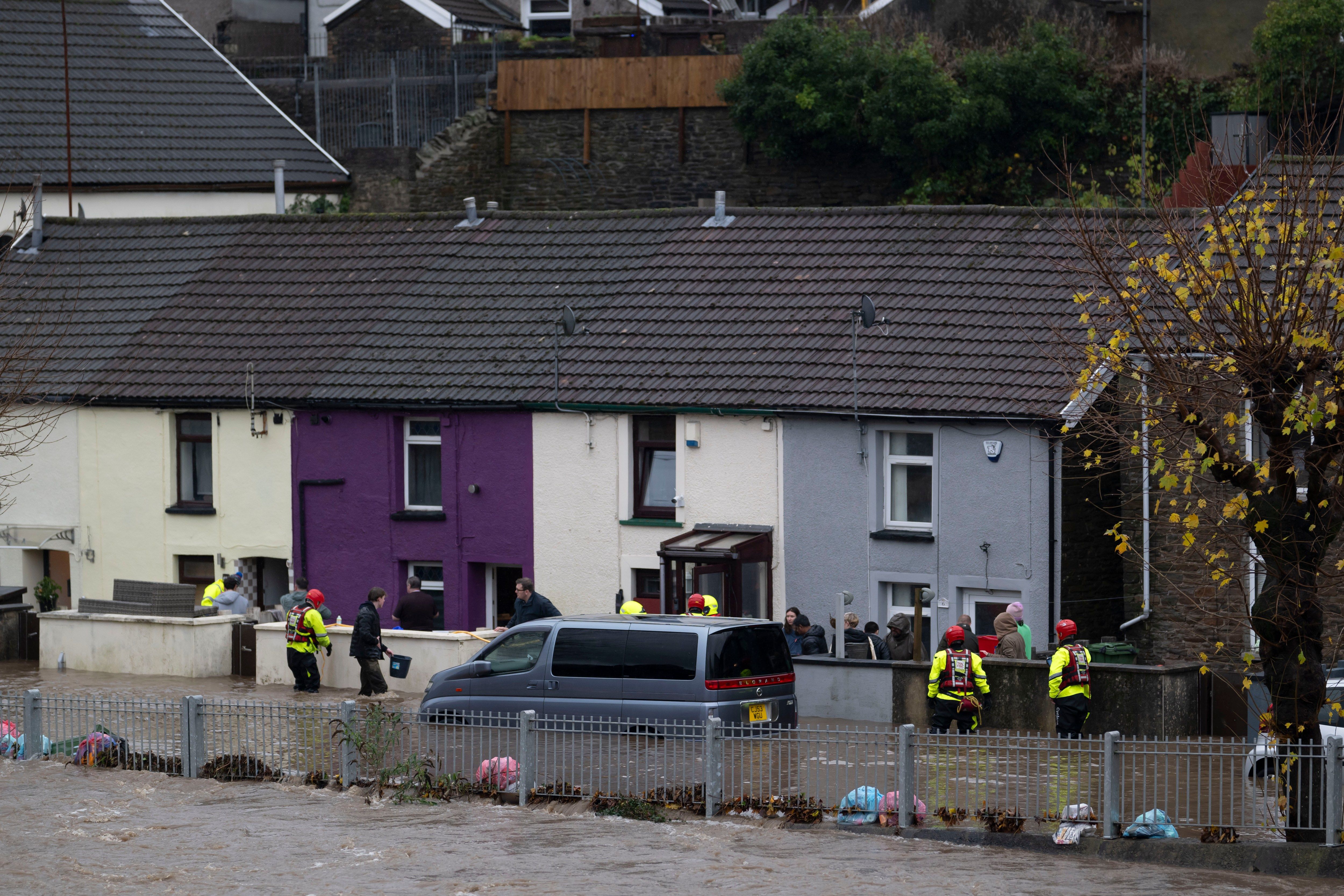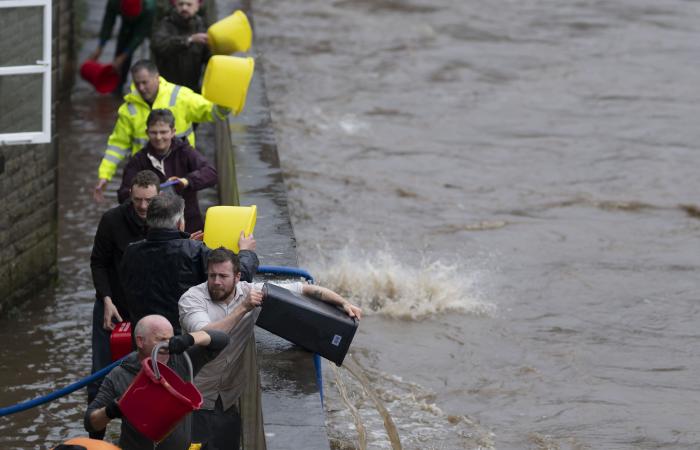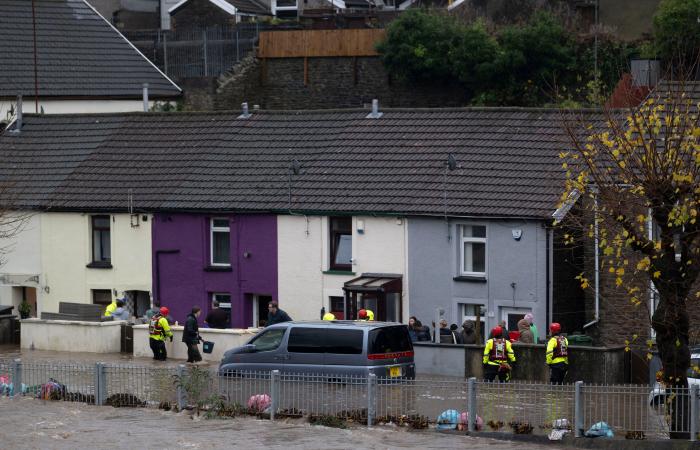When temperatures started to plummet at the beginning of last week, few people realised the extent of the weather rollercoaster ahead.
Snow had already fallen in northern Scotland and the arrival of a cold Arctic airmass, coupled with brisk northerly winds, pushed the mercury to levels that are usually seen in the depths of winter.
By Tuesday, people across swathes of the country opened their curtains to snow. Hundreds of schools were closed.
Warnings of the weather to come were yet to be issued, although forecasters were beginning to paint a picture of Storm Bert.
“Into the weekend, a more substantial change is on the way as an Atlantic area of low pressure looks to move in,” Chris Fawkes, the BBC meteorologist, told viewers of the Weather for the Week Ahead.
“[It’ll] bring milder weather for a time, but it’s also going to be bringing some very strong winds, gales or even severe gales for Saturday, with large battering waves.”
A BBC weather warnings showed the path of Storm Bert
BBC
On Thursday morning the Met Office named the area of low pressure. It is the second named storm of the winter. By Friday evening the Met Office had issued nine separate yellow and amber warnings for rain, wind, snow and ice over the weekend.
Tens of thousands of homes woke up without power on Saturday. Communities found themselves underwater on Sunday after rivers burst their banks.
Worcestershire County Cricket Club’s ground in New Road, below, was flooded on Monday after the River Severn burst its banks.
In Pontypridd in south Wales, residents said that lessons were not learnt from Storm Dennis, which left much of the town under water in 2020. One resident, John Pockett, said: “The one thing I think is appalling in this is: where was the warning? Nobody had heard anything at all.”
Residents in Pontypridd work together to relieve flooding on Sunday after the Taff broke its banks
MATTHEW HORWOOD/GETTY IMAGES

The Pontypridd Lido
MATTHEW HORWOOD/GETTY IMAGES

Rescuers help locals in Pontypridd
MATTHEW HORWOOD/GETTY IMAGES
This is how Storm Bert’s weekend of devastation, which left at least five people dead, unfolded.
Thursday: The storm is named
Further snowfall on Wednesday meant that tens of thousands of children woke up to news that their schools were closed on Thursday — some for a second day in a row.
In Exeter, at the Met Office headquarters, forecasters were increasingly turning their attention to the next band of weather. They announced that the forthcoming storm would be named Bert and that it was expected to bring gusts of wind of up to 70mph.
The Met Office added that further heavy snowfall could bring further disruption to parts of the country while heavy rain was also likely, especially in western parts.
Friday: Heightened warnings
The Met Office had stepped up its concern by Friday, warning that Storm Bert would be a “multi-hazard event” with “strong winds, some high snowfall accumulation, heavy rain, all in various different parts of the UK.”
Oli Claydon, a spokesman for the forecaster, said: “It’s quite a complex weather set-up for the weekend. Generally speaking, it’s a very unsettled weekend of weather ahead.”
By nightfall vast swathes of the country were expected to have yellow weather warnings for rain, wind and snow from Saturday morning. It had also issued two amber warnings of snow covering northeast England, northwest England, southwest Scotland, Lothian and Borders, Strathclyde, and Yorkshire and the Humber.
Saturday: The storm blows in
Tens of thousands of homes were without power by Saturday morning. Some 4,000 properties were affected in the Midlands, southwest England and south Wales, while 27,000 houses were affected in the northeast, Yorkshire and northern Lincolnshire.
Speaking at the time, Ross Easton, of Energy Networks Association, which represents Britain’s power network operators, said: “Forecasters are describing this as a ‘multi-hazard event’ with the worst of the weather yet to arrive, and so our members have extra engineers and contact centre teams available, and control rooms are monitoring the storm closely as it develops.”
More than a dozen flood warnings — where flooding was expected — had been issued while more than 100 flood alerts — where flooding was possible — were also in force.
As the storm raged, the death toll started to climb. Brian Perry, 75, disappeared while walking his dog in northwest Wales near the swollen Afon Conwy river. His body was found on Sunday.
On Saturday afternoon, a motorist in his eighties ploughed into a ford on Cockhill Lane in Foulridge, Lancashire. He was rushed to hospital where he later died. A woman, also in her eighties, was taken to hospital, but her condition is said to be stable.
West Yorkshire police said a 34-year-old man died in a single-vehicle collision in the early hours of Saturday. It was unclear if the incident was related to Storm Bert but it is understood the road was not icy. In Northamptonshire a man in his forties died in a crash on the A45 near Flore. It was not clear whether the incident was linked to the storm.
Sunday: Major incident declared
The true scale of the destruction became clear by Sunday morning. A major incident was declared in south Wales amid rising waters in several towns including Pontypridd, Ebbw Vale and Aberdare. Videos and pictures showed parts of Pontypridd under water. Cars were submerged and people living near the River Taff were forced to bail out properties.
Since the storm began in the early hours of Saturday, 149mm of rain had fallen in Tyn-Y-Waun in Mid Glamorgan. The average November fainfall for the area is 180mm, Greg Dewhurst, a Met Office meteorologist, said.
Welsh Water issued a boil water notice to customers in ten areas in south Wales, advising that their tap water may be contaminated because of flooding and must be boiled until further notice.
Rhondda Cynon Taf county borough council said the impact of the flooding was “looking to be more significant than the severe impact experienced during Storm Dennis.”
At a press conference in Pontypridd on Sunday afternoon, the council leader Andrew Morgan said the weather was worse than forecast.
“I am amazed that it was only a yellow weather warning issued,” he said. “We absolutely thought on Saturday … we were preparing for the possibility of an amber warning. It didn’t come but we took the decision ourselves to step up our resources and have depots open and crews in. I am surprised there wasn’t a red warning issued.
Devon Eason, club manager of Blackwood Rugby Club, Caerphilly, said he was “devastated” after the club’s building and grounds were damaged by the flood. He had spent thousands refurbishing the facilities just a few months ago, and the club will have to cancel several events while they try and rebuild the facilities.
A man in his sixties also died after a tree fell on a car on the A34 near Winchester, during the gales.
Monday: The clear-up begins
Rail services were severely hampered on Monday morning as Network Rail sought to clear lines and assess the damage. All Great Western Railway services on major routes were suspended. Trains between Liverpool Street in London and Stansted Airport were cancelled due to fallen trees on the line.
London Northwestern Railway reported that no rail services would operate through Northampton station after the River Nene burst its banks.
By Monday the clean-up operation was underway. Laura Jones, who owns a craft shop in Tenbury Wells, an area of Worcestershire, said she and her husband had been desperately trying to protect their shop from the floods but were forced to leave after hearing firemen tell them to “get out”.
Come the start of the working week they were not sure what’s next. “Everything’s been wiped out this time,” she told BBC Radio 5 Live. It was the second time in six weeks that their business had been hit by flooding.
In Wales the assessment was just beginning as communities sought to address the damage. Sian Williams from Natural Resources Wales (NRW) said the government body would look into complaints that warnings came too late.
NRW monitors river levels and Williams said initial flood alerts were issued for each river on Saturday evening.
Over the weekend, in 36 short hours, Storm Bert had dumped a huge amount of rain, especially over the hills of southwest England and south Wales. Some 193mm of rain fell on the slopes of Dartmoor in Devon, while 174mm fell in the hills of Bridgend county in Wales.
Storm Bert causes travel chaos across the country
Forecasters said the recent cold weather, followed by the mild Atlantic air that pushed in over the weekend, created a powerful, slow moving weather front.
Connor Turner, landlord of the Vine Tree in Crickhowell, Powys, had only finished redecorating the pub a few days ago. The business, on the south bank of the River Usk, had to close the restaurant on Sunday because of the flooding.
“For some reason it has become a normality,” he said. “People are saying we have just got to be resilient. Surely there is a permanent solution, that is the annoyance here.”









